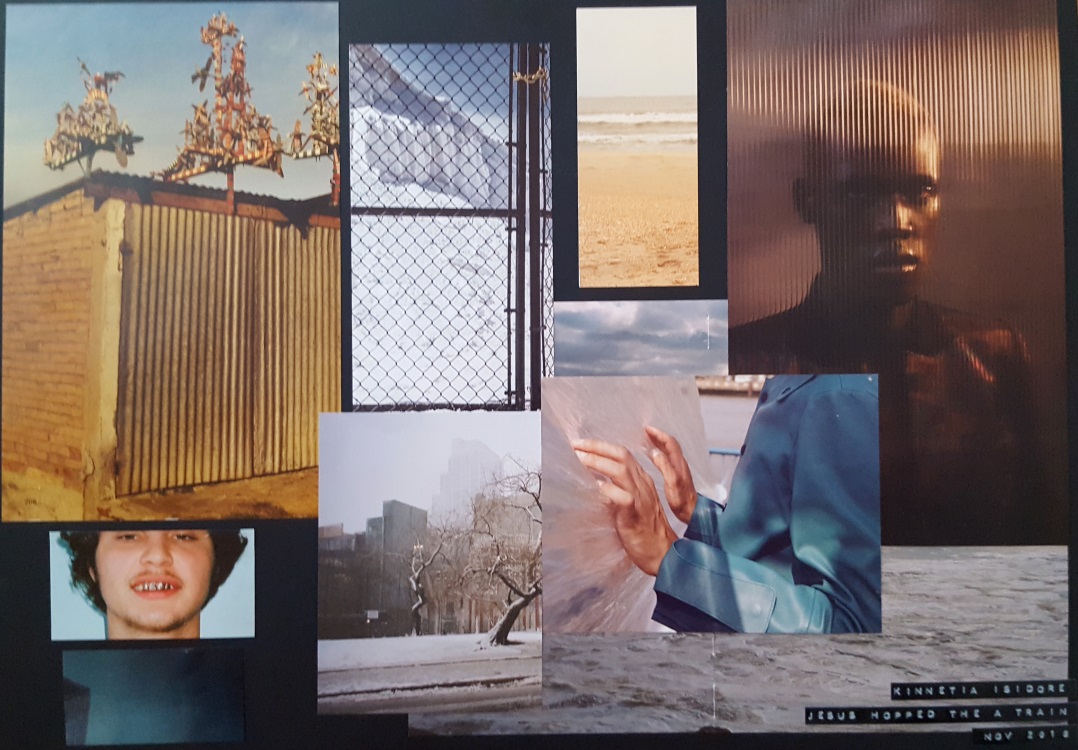Kinnetia Isidore is the costume designer behind our production of Stephen Adly Guirgis' Jesus Hopped the 'A' Train directed by Kate Hewitt. We asked her to give us an insight into the creative design process from script to stage.
Mood Boards
My costume design journey always begins with mood boards. Once I have read the script I like to begin by responding visually, this helps to spark ideas and begins to inform my design choices. Costume design, for me, is really about the psychology of the characters in a play, I really like to get into their heads and interrogate the choices they make in their clothing. I spend a lot of time looking at the setting of the play and trying to imagine what the characters would see on a daily basis. There is a very strong colour theme that came through in all of my mood boards for Jesus Hopped the ‘A’ Train. I took this from aerial shots of Rikers Island, in New York. This is the main setting of the play and all of our characters experience the brutality and starkness of the prison island.
The Inmates
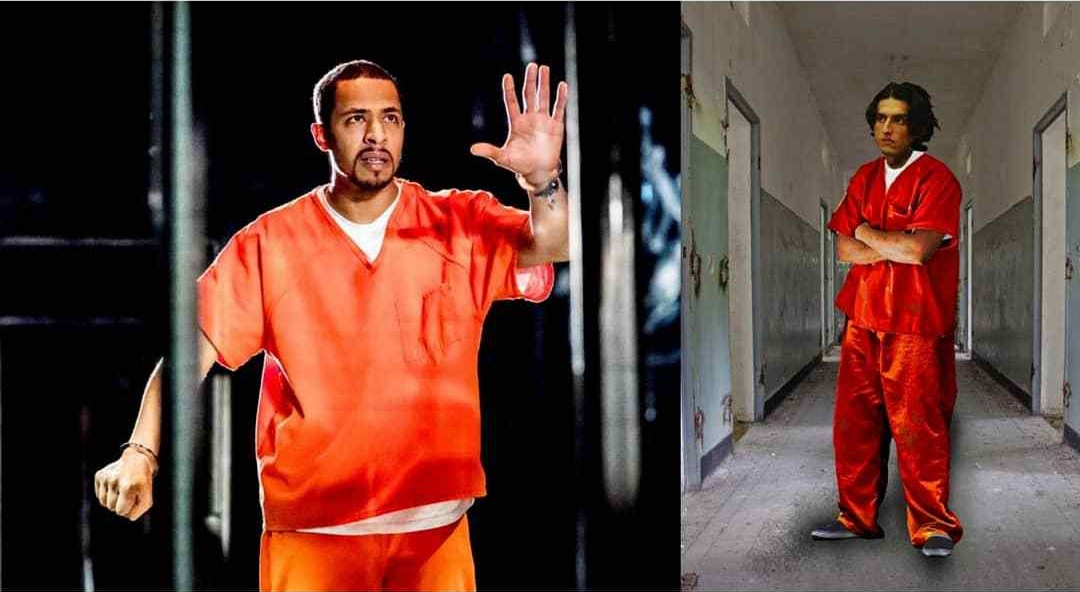
In a way, the costume design for this show was very limited due to 4/5 of the cast members wearing uniforms. We have a lawyer, two inmates and two correctional officers. As the set design was very minimalist Kate Hewitt and I felt that the costumes should be hyper-real. This meant sourcing genuine US prisoner uniforms to help bring our UK audience into the world of a New York prison. My costume supervisor, Rosey Morling, did an amazing job of managing to get hold of several sets of inmate and correctional officer uniforms, even sourcing genuine tool belts and accessories for the officers.
To achieve the filmic detail in the costumes I spent a lot of time researching how inmate uniforms are cared for and laundered. I discovered it is the inmates who are able to gain the ‘privilege’ of doing laundry duty. You do not get the same uniform back when it goes into the wash and are penalised for any attempt to mark or label the garments. Items are built to last but washed at soaring temperatures, giving them their saggy, worn out look. Our fabulous breakdown artist, Anna Smith, carried out the painstaking task of very gently wearing all of the uniforms down to look aged.
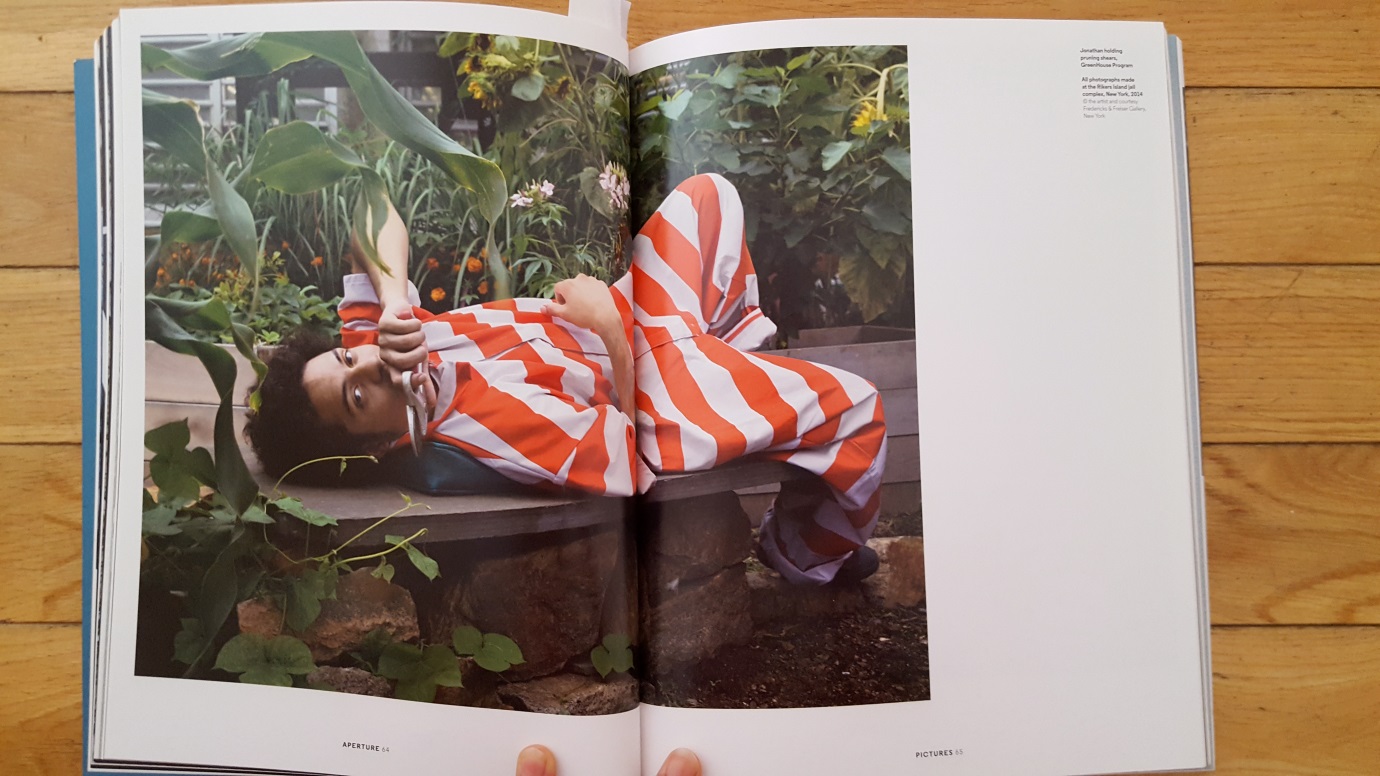
Reference image for Rikers inmates.
‘Jonathan holding pruning shears, GreenHouse Program’. All photographs made at the Rikers Island jail complex, New York, 2014. Copyright the artist and courtesy Fredericks & Freiser Gallery, New York. Lucas Foglia, Rikers Garden. Prison Nation, Aperture 230, Aperture Spring 2018, Publication No.: 0003-6420.
Angel Cruz, played by Ukweli Roach
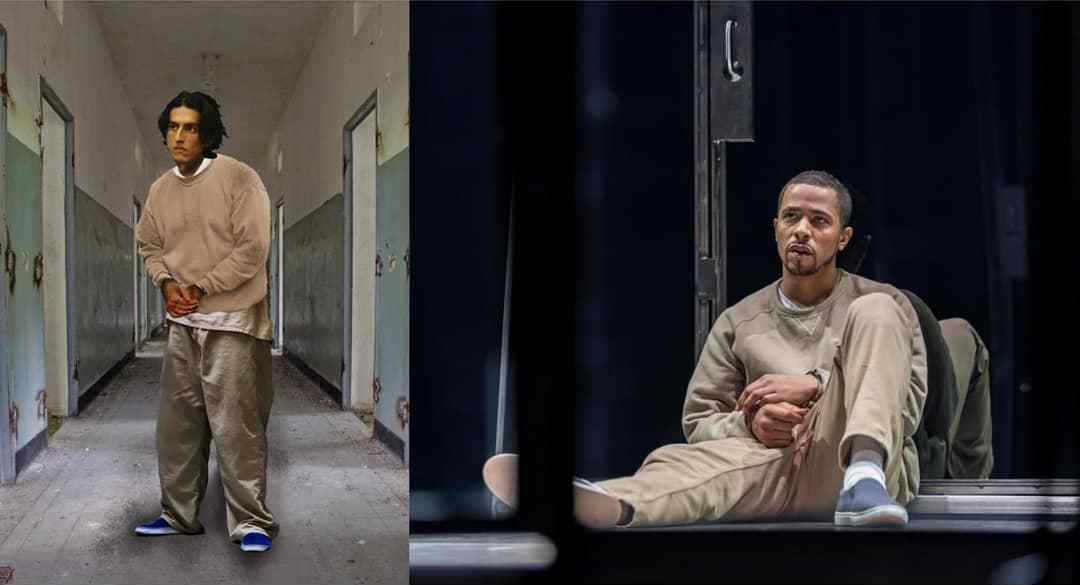
Angel Cruz is our 30 year old bike messenger who has been incarcerated for shooting a cult leader reverend in the ass, on a mission to save his friend from a cult. Angel begins his journey in Manhattan Correctional Center, ‘The Tombs’ in New York. We meet him on his first night of incarceration, when he is feeling vulnerable, as a new inmate.
My reference images for his costume came from a leaked Instagram video, recorded in 2016 by some inmates incarcerated in ‘The Tombs’. Rather than the classic orange jumpsuits that we are so used to seeing, inmates there wear a variety of beige two pieces with the option of a t-shirt and a raglan sleeve jumper. Sadly the inmates often wear jumpers for protection from attacks while they sleep, rather than for warmth. Angel starts off in a jumper and removes it later on when he meets Mary Jane for the second time and is feeling more relaxed. He also starts wearing his trousers a little lower and begins to roll up the hems, taking on a bit of influence from prison style.
Halfway through Act I Angel is moved to the notorious Rikers Island prison complex in New York. He exits the stage and does a quick change into his new orange inmate uniform. The orange uniforms have far more notoriety than any other colour and Kate and I had long discussions about the subconscious affect this would have on a UK audience. We are continually bombarded with US prison documentaries and TV shows, such as Orange is the New Black and we wanted to make sure we were making the right decision for the play. In the end, we decided on orange because we felt that Angel re-appearing in orange held such power over the emotion of the audience in that moment.
Angel goes on a slow journey of subconscious costuming as he gains confidence in Rikers and begins speaking back to the dominating serial killer, Lucius Jenkins. When he first enters Rikers it is after he has been beaten and raped in ‘The Tombs’, Valdez, the correctional officer, refers to him as ‘droopy dog’. He wears his trousers high on his waist and abandons the rolled up trouser cuffs he adopted in ‘The Tombs’. As we move through Act II we see him experimenting with rolling up his sleeves to show more muscle, wearing his trousers lower and tucking them into his socks (a style worn by adolescents in Rikers).
">
As an inmate you have a huge amount of your identity taken away from you when you are confined to wearing a uniform. Many inmates find ways to find identity in their clothing by adopting accessories. Angel wears a small diamond in his ear and sports Mary of Guadalupe tattoo on his left arm that we imagine he got for ‘protection’. His St. Anthony chain is revealed in the final moments of the play during Angel’s speech, “Saint Anthony, Saint Anthony, please come around, somethin’ is lost…”. This is a small detail that ties him to his public defender, Mary Jane, as she wears a small St. Christopher chain around her neck.
Reference image for Angel Cruz
To achieve the right look for Angel’s hair and facial hair I looked at a collection of works by Bruce Davidson. Davidson is a photographer who captured communities in East Harlem, inhabited by a large community of Puerto Ricans. Melissa Van Tongeran carefully followed a selection of reference images to create the final looks for Angel, Valdez, D’Amico and Lucius. Reference image for Angel Cruz’s hair
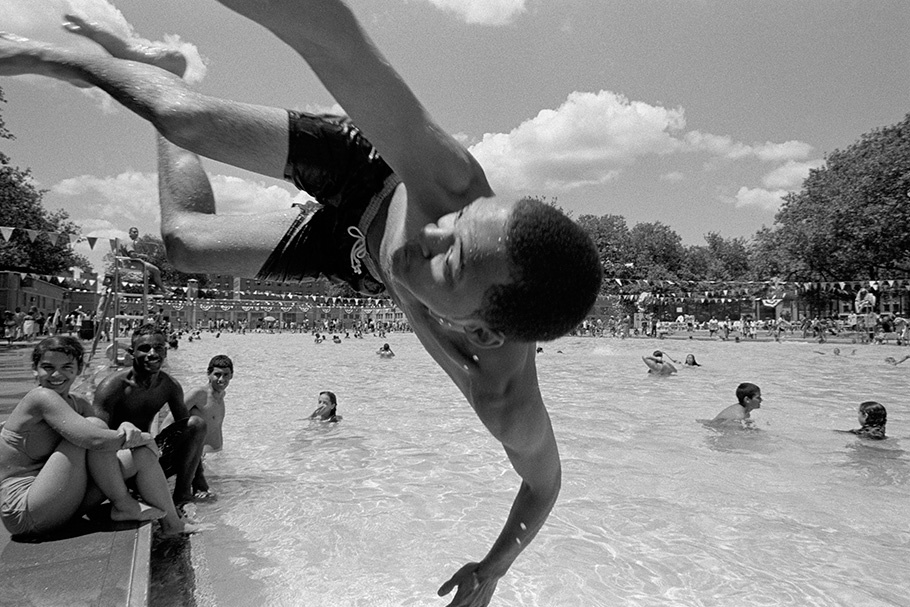 Bruce Davidson, East Harlem Revisited - Jefferson Pool, East Harlem, New York, 1998
Bruce Davidson, East Harlem Revisited - Jefferson Pool, East Harlem, New York, 1998Lucius Jenkins played by Oberon K. A. Adjepong
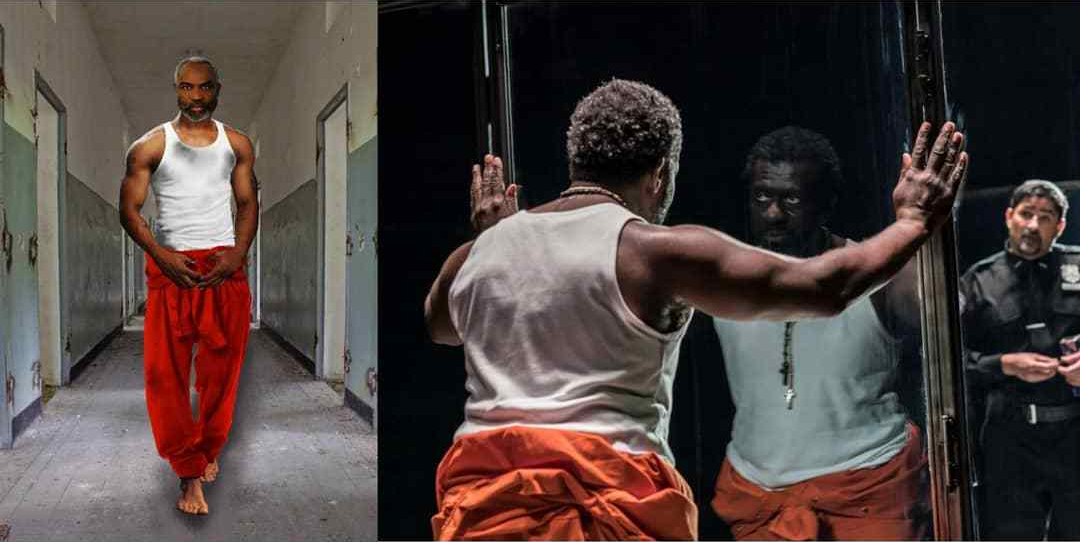
Lucius Jenkins is the charismatic born again serial killer who charms us through the play and shocks us with his attitude towards the brutality of his crimes. Lucius is an old hand in the prison game and has been incarcerated for a long time. He bends the rules a bit and manages to charm Officer D’Amico into sneaking him in all sorts of contraband.
Lucius wears an orange jumpsuit throughout the play. In the documentaries I watched, to research Rikers Island, it was noted that the older inmates tended to choose to wear jumpsuits and the younger inmates tended to choose two piece uniforms. New inmates feel safer in the two piece uniforms and find dressing and undressing an easier task, hence why our new inmate, Angel, wears a two piece. Lucius bends the rules a little by wearing a vest instead of the standard issue prison t-shirt. When we first meet him he is wearing a flashy pair of trainers which he loses when the strict rule-abiding Valdez takes over from the softer D’Amico. He wears his jumpsuit around his waist in his first few scenes and proudly sports not one, but two rosaries around his neck. Later on in the play, when he begins to get worn down in the run up to his execution, Lucius begins wearing his jumpsuit fully closed, as if he is shrinking away and losing his power.
https://www.youtube.com/watch?v=FAqf0sDkcz0&index=3&list=PLCCke8mUTs3ld…
The Correctional Officers
In Rikers Island, neither correctional officer uniforms nor inmate uniforms have changed much since the 1980s. Much of my research came from the writing and photographs of Lorenzo Steele Jr. and Jamel Shabazz, both correctional officers who worked in Rikers from the 1980s – 1990s. I found it fascinating to compare these photographs to the live imagery I found watching documentaries about Rikers, noting just how similar and static the uniforms were over such a long period of time.
My supervisor and I managed to source the genuine standard issue officers shirts and trousers for Valdez and D’Amico. Buying genuine officer badges was not an option so we had to be clever and re-create them. We had the arm patches embroidered using a graphic image of the ‘Correction Department City of New York’ logo. To create the unit ID on the collars and the officer ID badges Tony A Wood managed to mock up a shape for them, using templates, 3D printed them and applied a finish using silver leaf to make them look like real metal. The collar unit ID badges read ‘GRVC’ which stands for the ‘George R. Vierno Center’. This centre on Rikers Island is notorious for violent crime and hosts a 23 hour lockdown unit.
To find out which accessories an officer carried, I watched a lot of footage of officers in action, particularly a clip from ABC News, ‘Correctional Officer, A Day in the Life’, which follows Officer Graham going about his daily routine in a solitary confinement unit on Rikers Island. Most shockingly correctional officers do not carry weapons. We managed to source the genuine holders for handcuffs, torches, inspection gloves and keys.
Valdez played by Joplin Sibtain
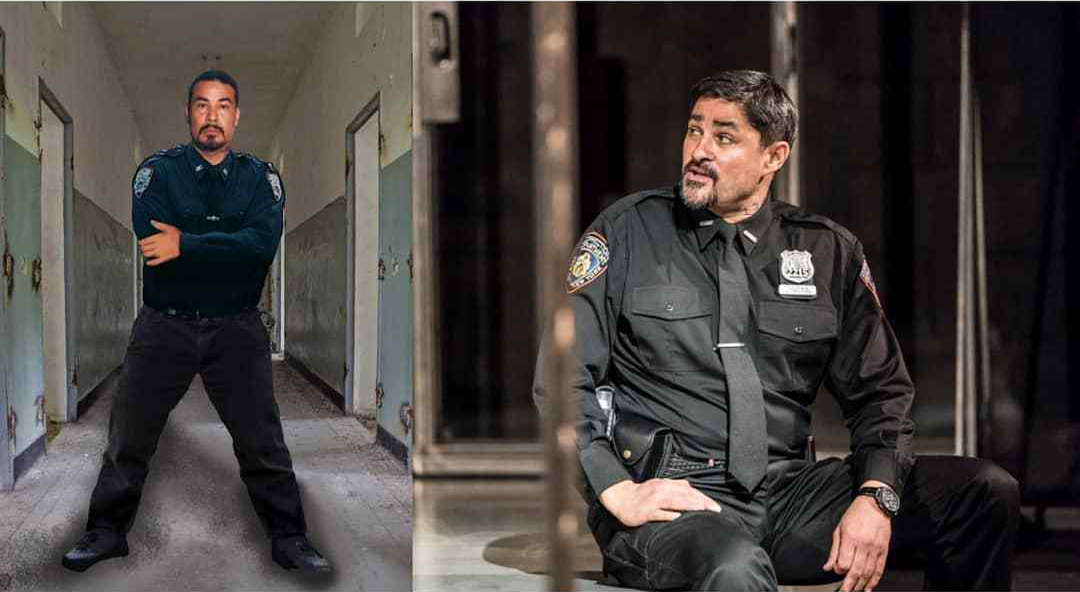
Valdez is a rule following, law abiding citizen who believes criminals should be punished harshly and held responsible for his crimes. Throughout the play he taunts the prisoners and frequently refers to them as various animals. Although every character in the play is complex, no body holding a morality that is completely black and white, Valdez is often depicted as the ‘bad cop’ officer. To play on this idea, Valdez’s uniform is fully black. His shoes are heavy, suggesting power and dominance, the inmates can hear him coming before he enters. He has the larger of the accessory belts and wears it slung low, almost like a cowboy holster. His officer number, 2215, is taken from a bible verse, which I felt related to his character and some of the text he uses in the play. I felt it also played on the theme of religion in the play. It is a subtle detail that the audience won’t pick up on, but it was something for myself and the actors to think about when creating their characters.
Revelations 22:15, The Holy Bible
“Outside are the dogs, those who practice magic arts, the sexually immoral, the murderers, the idolaters and everyone who loves and practices falsehood.”
Charlie D’Amico played by Matthew Douglas
D’Amico is a husband and a father, a friendly character who almost marvels at Lucius’ notoriety and celebrity. He sneaks in contraband and enlists his wife to help. D’Amico is often depicted as the ‘good cop’, even though his actions in the play are rather dubious. To play on this idea D’Amico wears a pale blue short sleeved shirt. Blue is said to have a calming effect on the mind and is most often used for nursing uniforms and scrubs in hospitals. Correctional officers face having dreadful things thrown at them on a daily basis: food, urine, faeces…the list is horrifying. D’Amico seems to have managed to charm one of the most dangerous criminals in the 23hour lock-down unit, so I imagine he wouldn’t be worried about covering up his arms for fear of things being hurled at him while on duty. His officer number, 1618, is also taken from a bible verse which I felt related to his character and some of the text he uses in the play.
Romans 16:18, The Holy Bible
“For such people are not serving our Lord Christ, but their own appetites. By smooth talk and flattery they deceive the minds of naïve people.”
Reference image for Charlie D’Amico
Mary Jane Hanrahan played by Dervla Kirwan
Mary Jane Hanrahan is a hard working public defender who earns a small salary but has clawed her way through a male dominated industry to win several cases. She is practical but spunky and I wanted to show this in her costume. Although Mary Jane isn’t confined to wearing a uniform, the restrictions on visitors to prison complexes make her clothing take on a uniform like quality. She and Charlie D’Amico are the only two characters who give us a sense of the period the play is set in, through their costumes. It was important to me that they felt timeless, this story is one that has rung true in the real world for many years and I didn’t want to limit its possibilities with a very modern or a very period costume.
During my research for Mary Jane, I realised that a female public defender would not only be restricted by the visitation regulations on clothing that prisons impose, they often face jibes from male prisoners just because of their gender. In my original design I put her in a boxy, practical two piece suit with a practical pair of loafers. It is neither revealing nor does it draw too much attention to her. While sourcing the costumes my supervisor and I stumbled across the perfect suit for Mary Jane, and it was green! It felt perfect as a subconscious herald to her Irish heritage, which she mentions several times in the play. She wears simple, plain accessories and a St. Christopher chain around her neck. This is to subconsciously draw a connection between her and Angel, as he wears a St. Anthony medallion around his neck.
Visitor information from the Federal Bureau of Prisons.
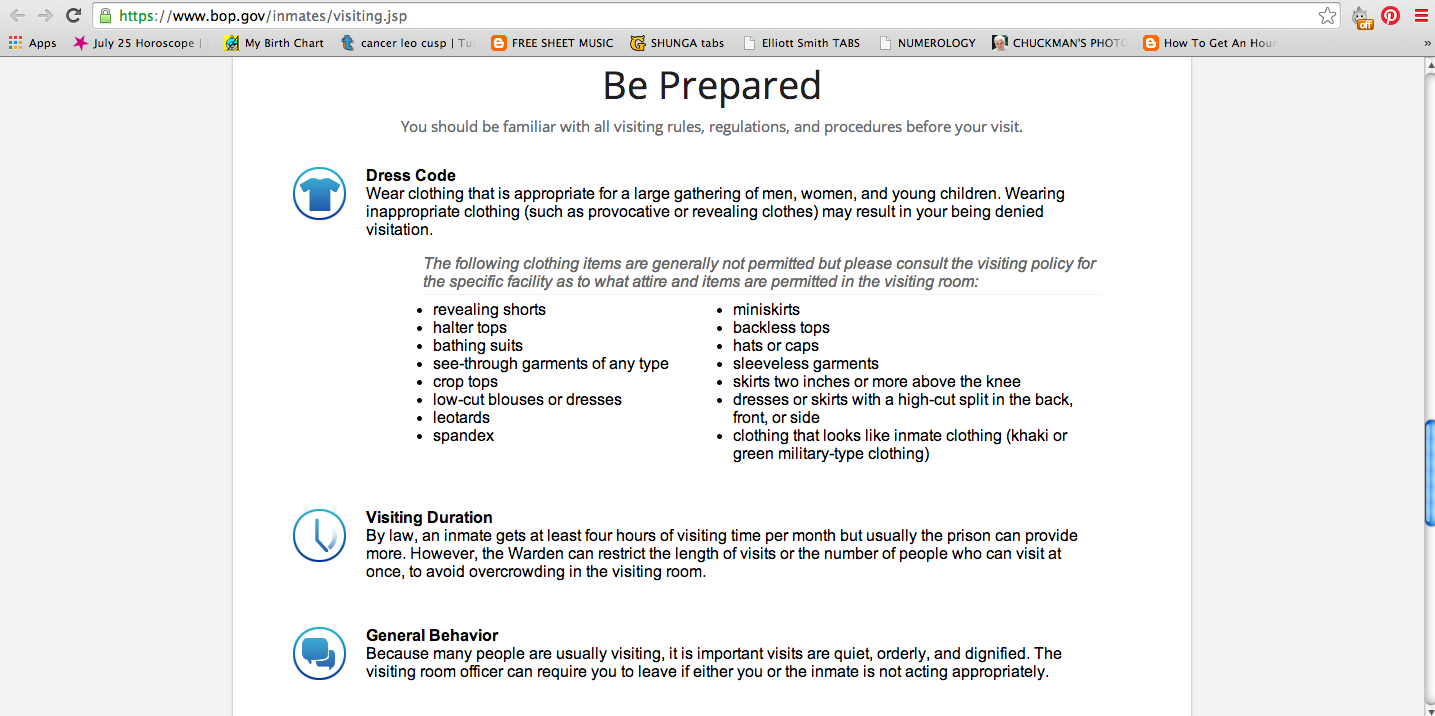
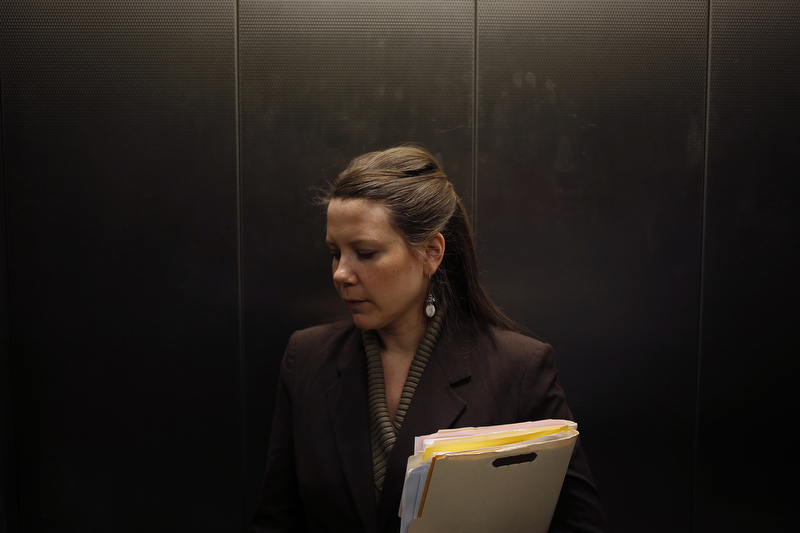
Reference image for Mary Jane: Public Defender Colleen Polak rides an elevator to meet with a client in detention at the St. Louis County Jail in St. Louis, Mo. on Thursday, January 23, 2014. Public defenders take a substantial pay cut in comparison with lawyers who work for private firms. Luke Sharrett, photojournalist for The New York Times. http://sharrett.blogspot.com/2014/05/public-defenders-for-new-york-times.html
Jesus Hopped the 'A' Train by Stephen Adly Guirgis runs at the Young Vic until 6 April.
Director Kate Hewitt
Set Designer Magda Willi
Costume Designer Kinnetia Isidore
Lighting Designer Guy Hoare
Sound Designer Peter Rice
Movement Director Imogen Knight
UK Casting Director Julia Horan CDG
US Casting Director Jim Carnahan CSA
With Oberon K. A. Adjepong, Matthew Douglas, Dervla Kirwan, Ukweli Roach and Joplin Sibtain

